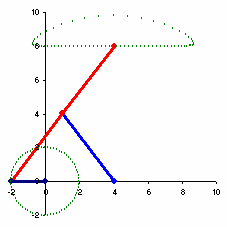Polynomial Cam Function (Introduction) - Part 1
Fundamental Law of Cam Design
(1) The cam function must be continuous through the first and second derivatives of displacement across the entire interval (360 degrees)*
(2) The jerk function must be finite across the entire interval (360 degrees)*
Normally the motion from cam cannot be defined by only a single mathematical expression, it consists of different equation on each different segment e.g. sector A-B uses cycloidal motion, sector B-C has dwell function (R=constant), sector C-D uses cycloidal motion again to come back to its starting point, and sector D-A has dwell function. We don't combine these 4 segments into only one equation, but we separate the functions to define the movement of cam follower behavior over each segment and make sure that there is no discontinuity in the displacement, velocity and acceleration functions.
Any discontinuity in the acceleration function will lead to infinite spikes (derivative of acceleration). The derivative of acceleration is called "jerk". And infinite jerk is unacceptable because it will lead to high vibration of the mechanism.
Cyloidal cam function is the example that jerk function has finite value. But cycloidal cam function has limited capability because it has to start from rest and end at rest again (start velocity = 0 and end velocity = 0). With the use of polynomial cam function, we will have more freedom to fine tune the start and end velocity. This will help a lot to control the impact speed (if there is any) when using polynomial function together with linear function. We will discuss more about the derivation and the how to use. At the end, we will make an excel program to calculate the displacement, velocity and acceleration of the follower with necessary graphing details.
I use fifth-degree polynomial in my design and I found it very useful to work in most application because I have more freedom to control the start and end velocity and can use it to connect to another function easier.
General form of fifth-degree polynomial cam function is as follows:
s = c0 + c1 x (b/bm) + c2 x (b/bm)2 + c3 x (b/bm)3 + c4 x (b/bm)4 + c5 x (b/bm)2
In the [Polynomial Cam Function (Derivation of Fifth-degree function) - Part 2], we will set the necessary boundary conditions and solve for the values of all constants so that we can have the final equation of fifth-degree polynomial cam function to use in cam design.
(1) The cam function must be continuous through the first and second derivatives of displacement across the entire interval (360 degrees)*
(2) The jerk function must be finite across the entire interval (360 degrees)*
Normally the motion from cam cannot be defined by only a single mathematical expression, it consists of different equation on each different segment e.g. sector A-B uses cycloidal motion, sector B-C has dwell function (R=constant), sector C-D uses cycloidal motion again to come back to its starting point, and sector D-A has dwell function. We don't combine these 4 segments into only one equation, but we separate the functions to define the movement of cam follower behavior over each segment and make sure that there is no discontinuity in the displacement, velocity and acceleration functions.
Any discontinuity in the acceleration function will lead to infinite spikes (derivative of acceleration). The derivative of acceleration is called "jerk". And infinite jerk is unacceptable because it will lead to high vibration of the mechanism.
Cyloidal cam function is the example that jerk function has finite value. But cycloidal cam function has limited capability because it has to start from rest and end at rest again (start velocity = 0 and end velocity = 0). With the use of polynomial cam function, we will have more freedom to fine tune the start and end velocity. This will help a lot to control the impact speed (if there is any) when using polynomial function together with linear function. We will discuss more about the derivation and the how to use. At the end, we will make an excel program to calculate the displacement, velocity and acceleration of the follower with necessary graphing details.
I use fifth-degree polynomial in my design and I found it very useful to work in most application because I have more freedom to control the start and end velocity and can use it to connect to another function easier.
General form of fifth-degree polynomial cam function is as follows:
s = c0 + c1 x (b/bm) + c2 x (b/bm)2 + c3 x (b/bm)3 + c4 x (b/bm)4 + c5 x (b/bm)2
In the [Polynomial Cam Function (Derivation of Fifth-degree function) - Part 2], we will set the necessary boundary conditions and solve for the values of all constants so that we can have the final equation of fifth-degree polynomial cam function to use in cam design.




Comments